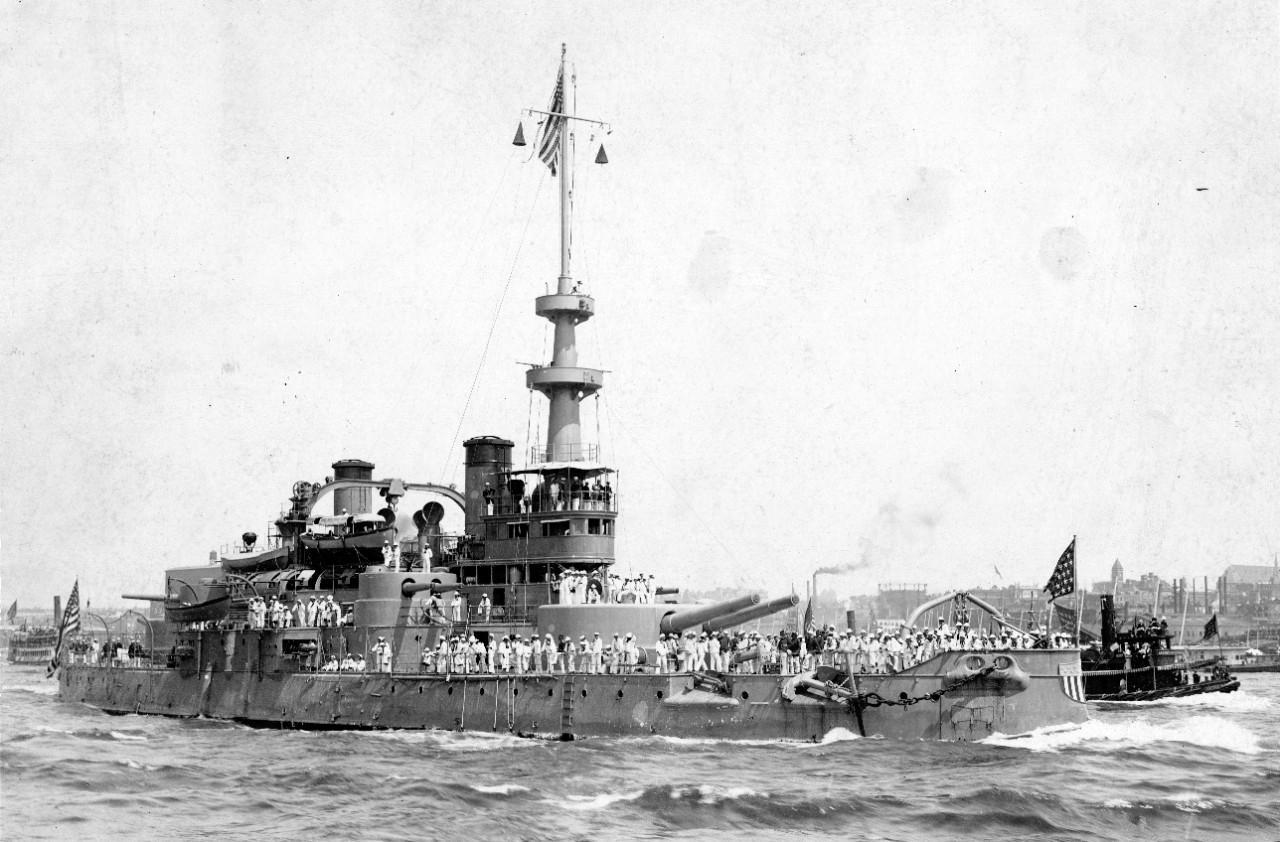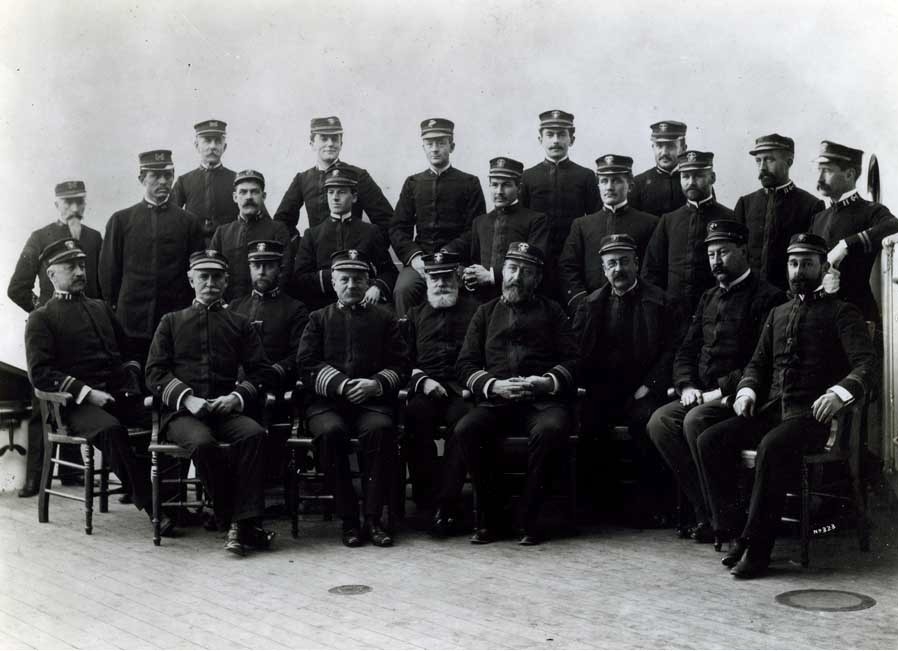Oregon II (Battleship No. 3)
1896-1942
The 33rd State of the Union, admitted on 14 February 1859.
II
(Battleship No. 3: displacement 11,688; length 351'2"; beam 69'3"; draft 24'0"; speed 16 knots; complement 473; armament 4 13-inch, 8 8-inch 4 6-inch; 20 6-pounder, 6 1-pounder, 6 18-inch torpedo tubes; class Indiana)
The second Oregon (Battleship No. 3) was laid down on 19 November 1891 at San Francisco, Calif., by Union Iron Works; launched on 26 October 1893; sponsored by Miss Daisy Ainsworth; and commissioned on 15 July 1896, Capt. Henry L. Howison in command.
After commissioning, Oregon was fitted out for duty on the Pacific Station, where she served for a short time. Leaving dry dock on 16 February 1898, she received news that Maine had blown up in Havana harbor the previous day. As tensions with Spain grew, on 9 March Oregon arrived in San Francisco and loaded ammunition. Three days later, she was ordered to embark on what was to become one of the most dramatic voyages ever undertaken by a ship of the U.S. Navy.
Oregon departed San Francisco on 19 March 1898 for Callao, Peru, the first coaling stop on her trip around South America to the East Coast of the U.S. Arriving at Callao on 4 April and departing several days later, Capt. Charles E. Clark, her commanding officer, elected not to stop at Valparaiso, Chile, for coal but to continue on through the Straits of Magellan. On 16 April, Oregon entered the Straits and encountered a terrific gale that obscured the perilously close rocky coastline. For a time she was in great danger, but just after dark she let go her anchors on a rocky shelf fringed by islets and reefs, and safely weathered the night. Before dawn on the 17th, the gale moderated and Oregon proceeded around Cape Forward to Punta Arenas, where she was joined by gunboat Marietta, also sailing to the East Coast.
Both ships coaled and departed on 21 April 1898 for Rio de Janeiro, keeping their guns manned all the while for a Spanish torpedo boat rumored to be in the area. Head seas and winds delayed them, and they did not reach Rio until 30 April. There Oregon received news of the declaration of war against Spain, and on 4 May she left on the next leg of her journey. With a brief stop in Bahia, Brazil, she arrived at Barbados for coal on 18 May, and, on the 24th, anchored off Jupiter Inlet, Fla., reporting ready for battle. Altogether, Oregon had sailed over 14,000 miles since leaving San Francisco 66 days earlier. On one hand the feat had demonstrated the many capabilities of a heavy battleship in all conditions of wind and sea. On the other it swept away all opposition for the construction of the Panama Canal, for it was then made clear that the country could not afford to take two months to send warships from one coast to the other each time an emergency arose.
On 26 May 1898 Oregon proceeded to Key West, joined Rear Adm. William T. Sampson's fleet two days later, and on 1 June arrived off Santiago, Cuba, to shell military installations and to help in the destruction of Admiral Cervera's fleet on 3 July. Oregon then went to the New York Navy Yard for a refit, and in October sailed for the Asiatic station.
She arrived at Manila on 18 March 1899 and remained in the area until the following February. In cooperating with the Army during the Philippine insurrection, the battleship performed blockade duty in Manila Bay and off Lingayen Gulf, served as a station ship, and aided in the capture of Vigan.
Departing Cavite 13 February 1900, Oregon cruised in Japanese waters until May when she went to Hong Kong. Under orders then to proceed to Taku on account of the Boxer Rebellion, she departed on 23 June for that northern port; and, on the 28th, while steaming through the Straits of Pechili, she grounded on an uncharted rock. Suffering some damage and taking on water, the battleship was in a precarious situation for a week. On 5 July, Oregon was refloated and the following day was towed to Hope Sound for temporary repair. Arriving at Kure, Japan, on 17 July she was placed in dry dock at the naval station there for final repairs.
On 29 August 1900 the battleship departed again for the coast of China and cruised off the Yangtze River and served as station ship at Woosung. On 5 May 1901 she got underway for the United States. Sailing via Yokohama and Honolulu, she arrived at San Francisco on 12 June and entered Puget Sound Navy Yard on 6 July for overhaul.
Remaining in the Puget Sound area for well over a year, it was not until 18 March 1903 that Oregon returned to Asiatic waters, and arrived in Hong Kong on that day. Visiting various Chinese, Japanese, and Philippine ports, the battleship remained in the Far East until returning to the West Coast in February 1906. She decommissioned at the Puget Sound Navy Yard on 27 April 1906.
Oregon was recommissioned on 29 August 1911, but remained in reserve until October, when she sailed to San Diego. The following years proved ones of relative inactivity for the aging veteran, as she operated out of West Coast ports. On 9 April 1913, she was placed in ordinary at Bremerton, Wash., and on 16 September 1914 went into a reserve status, although she remained in commission. On 2 January 1915 she was again in full commission and sailed to San Francisco for the Panama-Pacific International Exposition. From 11 February 1916 to 7 April 1917 she was placed in commission in reserve, this time at San Francisco.
Returned to full commission again on the latter date, Oregon remained first on the West Coast, then acted as one of the escorts for transports of the Siberian Expedition. With World War I over, on 12 June 1919 she decommissioned at Bremerton. From 21 August to 4 October of that year she recommissioned briefly and was the reviewing ship for President Woodrow Wilson during the arrival of the Pacific Fleet at Seattle.
With the adoption of ship classification symbols on 17 July 1920, Oregon was redesignated BB-3. In 1921, a movement was begun to preserve the battleship as an object of historic and sentimental interest, and to lay her up permanently at some port in Oregon.
In accordance with the Washington Naval Treaty, Oregon was rendered incapable of further warlike service on 4 January 1924, and was retained on the Navy List as a naval relic with a classification of "unclassified." In June 1925 she was loaned to the State of Oregon, restored, and moored at Portland as a floating monument and museum, to be visited by thousands in the ensuing years.
On 17 February 1941, when identifying numbers were assigned to unclassified vessels, Oregon was redesignated IX-22. With the outbreak of World War II, it was deemed that the scrap value of the old veteran was vital and necessary to the war effort of the nation. Accordingly, she was stricken from the Navy List on 2 November 1942 and sold on 7 December.
Towed to Kalima, Wash., the following March [1943] for dismantling, the Navy requested that the scrapping process be halted when progress reached the main deck and after the ship's interior had been cleared out. She was returned to the Navy to be used as a storage hulk or breakwater in connection with the reconquest of Guam, and by July 1944 she had been loaded with dynamite and other types of ammunition and towed to that island.
The hulk of the old battleship remained at Guam for several years; during a typhoon on 14-15 November 1948, she broke her moorings and drifted to sea. Finally, on 8 December, the old warrior was located by search planes some 500 miles southeast of Guam and towed back. She was sold on 15 March 1956 to the Massey Supply Corp.; resold to the Iwai Sanggo Co.; towed to Kawasaki, Japan; and scrapped.




